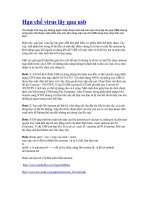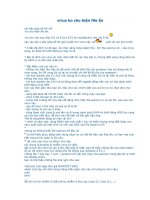Virus structure tutorial STEM
Bạn đang xem bản rút gọn của tài liệu. Xem và tải ngay bản đầy đủ của tài liệu tại đây (2.02 MB, 29 trang )
Introduction to Virus Structure
Tutorial
Jonathan King, Peter Weigele, Greg Pintilie, David Gossard
(MIT)
v.November, 2008
Virus Structure
•
Size
–
17 nm – 3000 nm diameter
•
Basic shape
–
Rod-like
–
“Spherical”
•
Protective Shell - Capsid
–
Made of many identical protein
subunits
–
Symmetrically organized
–
50% of weight
–
Enveloped or non-enveloped
•
Genomic material
–
DNA or RNA
–
Single- or double-stranded
Virus Structure
•
Virus capsids function in:
–
Packaging and protecting nucleic acid
–
Host cell recognition
•
Protein on coat or envelope “feels” or “recognizes”
host cell receptors
–
Genomic material delivery
•
Enveloped: cell fusion event
•
Non-enveloped: more complex strategies &
specialized structures
Electron Microscopy
Mitra, K. & Frank, J., 2006. Ribosome dynamics: insights from atomic structure modeling into cryo-electron
microscopy maps. Annual review of biophysics and biomolecular structure, 35, 299-317.
History
•
In 1953, Crick & Watson proposed … principles of virus
structure
–
Key insight:
•
Limited volume of virion capsid => nucleic acid
sufficient to code for only a few sorts of proteins of
limited size
–
Conclusion:
•
Identical subunits in identical environments
•
Icosahedral, dodecahedral symmetry
X-ray Crystallography of Viruses
•
Symmetry of protein shells makes them uniquely
well-suited to crystallographic methods
•
Viruses are the largest assemblies of biological
macromolecules whose structures have been
determined at high resolution
History con’t
•
In 50’s & 60’s Klug and others confirmed that
several (unrelated) “spherical” viruses had
icosahedral symmetry
–
(Used negative staining & electron microscopy)
•
Conclusion:
–
Icosahedral symmetry is preferred in virus structure
Similarity to Buckminster Fuller’s
Geodesic Domes
Icosahedral Symmetry
•
12 vertices
•
20 faces
(equilateral triangles)
•
5-3-2 symmetry axes
•
60 identical* subunits
in identical environments
can form icosahedral shell
* asymmetric
Caspar and Klug’s Icosahedral
shell
But …
•
Clear evolutionary pressure to make larger capsid
–
Using larger subunits helps very little
–
Using more subunits helps a lot
•
Not possible to form icosahedral shell (of identical units in identical
environments) with more than 60 subunits
•
Viruses with more than 60 subunits were observed
•
Question:
–
How can >60 subunits form an icosahedral shell?
–
Will any number of subunits work?
–
If so, how would they be organized?
Quasi-equivalence
•
In 1962, Caspar & Klug proposed the theory of “quasi-
equivalence”
–
Not all protein subunits are equivalent
•
“Identical” subunits in slightly different
environments
–
Only certain numbers of subunits will can be packed
into closed regular lattice.
Caspar & Klug, Cold Spring Harbor, 1962
Quasi-equivalence
•
Subunits are in “minimally”
different environments
–
Pentamers at vertices
–
Hexamers elsewhere
•
Predicts packing arrangements
of larger capsids
–
Shift from T1 to T4 packing
=> 8-fold increase in volume
Spherical viruses have icosahedral symmetry
Homunculattice
HK97 Asymmetric Unit
Outside Inside
from Wah Chiu and Frazer Rixon in Virus Research (2002)
Herpes Simplex Virus at 8.5 Å resolution
Influenza
•
Infection depends on spike proteins projecting from capsid
membrane called “Hemagglutinin (HA)”
•
These bind sugar molecules on cell surface
•
Much of the difference between Hong Kong flu, Swine flu,
Bird flu, and other strains, is in the amino acid sequence
and conformation of the HA protein.
•
These differences control what host cell types the virus can
infect.
•
Immunization against flu involves your immune system
synthesizing antibody proteins that bind the HA protein.
In#uenza virus
entry of in#uenza
into cell
composition of virus
low pH
100 Å displacement
of fusion peptide
fusion peptide
In#uenza hemagglutinin:
a pH induced, conformationally controlled trigger
for membrane fusion
backbone is
structured
disordered loop
Qiao et al. Membrane Fusion Activity of In#uenza Hemagglutinin. The Journal of Cell Biology, Volume 141, 1998
Influenza Hemagglutinin
•
The HA spikes extend like a spring during infection
/> />
Trimer Structure
•
Long alpha helices form
coiled coil structure
•
In mature trimers of HA0,
each monomer is cleaved
into HA1 and HA2.
Evolution of dsDNA viruses
•
All known viruses, whether infecting bacteria or humans,
may have evolved from a single common ancestor,
relatively early in the evolution of organisms.
Common steps in the assembly of all dsDNA
viruses
•
Unique portal ring at one Vertex
•
Scaffolding proteins
•
Procapsid assembled empty of DNA
•
DNA pumped into procapsid through portal ring
•
DNA moves back through portal to enter cell









